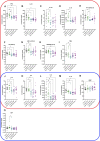Characterization of cannabinoid plasma concentration, maternal health, and cytokine levels in a rat model of prenatal Cannabis smoke exposure
- PMID: 38030657
- PMCID: PMC10687022
- DOI: 10.1038/s41598-023-47861-8
Characterization of cannabinoid plasma concentration, maternal health, and cytokine levels in a rat model of prenatal Cannabis smoke exposure
Abstract
Cannabis sativa has gained popularity as a "natural substance", leading many to falsely assume that it is not harmful. This assumption has been documented amongst pregnant mothers, many of whom consider Cannabis use during pregnancy as benign. The purpose of this study was to validate a Cannabis smoke exposure model in pregnant rats by determining the plasma levels of cannabinoids and associated metabolites in the dams after exposure to either Cannabis smoke or injected cannabinoids. Maternal and fetal cytokine and chemokine profiles were also assessed after exposure. Pregnant Sprague-Dawley rats were treated daily from gestational day 6-20 with either room air, i.p. vehicle, inhaled high-Δ9-tetrahydrocannabinol (THC) (18% THC, 0.1% cannabidiol [CBD]) smoke, inhaled high-CBD (0.7% THC, 13% CBD) smoke, 3 mg/kg i.p. THC, or 10 mg/kg i.p. CBD. Our data reveal that THC and CBD, but not their metabolites, accumulate in maternal plasma after repeated exposures. Injection of THC or CBD was associated with fewer offspring and increased uterine reabsorption events. For cytokines and chemokines, injection of THC or CBD up-regulated several pro-inflammatory cytokines compared to control or high-THC smoke or high-CBD smoke in placental and fetal brain tissue, whereas smoke exposure was generally associated with reduced cytokine and chemokine concentrations in placental and fetal brain tissue compared to controls. These results support existing, but limited, knowledge on how different routes of administration contribute to inconsistent manifestations of cannabinoid-mediated effects on pregnancy. Smoked Cannabis is still the most common means of human consumption, and more preclinical investigation is needed to determine the effects of smoke inhalation on developmental and behavioural trajectories.
© 2023. The Author(s).
Conflict of interest statement
RBL has worked as a consultant on recent medico-legal cases involving
Figures






Similar articles
-
Differential effects of gestational Cannabis smoke and phytocannabinoid injections on male and female rat offspring behavior.Prog Neuropsychopharmacol Biol Psychiatry. 2025 Jan 10;136:111241. doi: 10.1016/j.pnpbp.2024.111241. Epub 2025 Jan 5. Prog Neuropsychopharmacol Biol Psychiatry. 2025. PMID: 39765319
-
Differential inflammatory profile in the lungs of mice exposed to cannabis smoke with varying THC:CBD ratio.Arch Toxicol. 2023 Jul;97(7):1963-1978. doi: 10.1007/s00204-023-03514-3. Epub 2023 May 14. Arch Toxicol. 2023. PMID: 37179517 Free PMC article.
-
Dissociable changes in spike and wave discharges following exposure to injected cannabinoids and smoked cannabis in Genetic Absence Epilepsy Rats from Strasbourg.Eur J Neurosci. 2022 Feb;55(4):1063-1078. doi: 10.1111/ejn.15096. Epub 2021 Jan 23. Eur J Neurosci. 2022. PMID: 33370468
-
Using the BMD Approach to Derive Acceptable Daily Intakes of Cannabidiol (CBD) and Tetrahydrocannabinol (THC) Relevant to Electronic Cigarette Liquids.Front Biosci (Landmark Ed). 2022 Jul 25;27(8):228. doi: 10.31083/j.fbl2708228. Front Biosci (Landmark Ed). 2022. PMID: 36042166
-
THC and CBD: Villain versus Hero? Insights into Adolescent Exposure.Int J Mol Sci. 2023 Mar 9;24(6):5251. doi: 10.3390/ijms24065251. Int J Mol Sci. 2023. PMID: 36982327 Free PMC article. Review.
Cited by
-
Divergent outcomes of delta 9 - tetrahydrocannabinol (THC) in adolescence on mesocortical dopamine and cognitive development in male and female mice.Psychopharmacology (Berl). 2025 Jul 14. doi: 10.1007/s00213-025-06791-1. Online ahead of print. Psychopharmacology (Berl). 2025. PMID: 40658196
-
The changing landscape of cannabis use: impact on maternal health and neonatal outcomes.Pediatr Res. 2025 Jun 20. doi: 10.1038/s41390-025-04209-4. Online ahead of print. Pediatr Res. 2025. PMID: 40542098 Review.
-
Perinatal omega-3 sex-selectively mitigates neuropsychiatric impacts of prenatal THC in the cortico-striatal-hippocampal circuit.Mol Psychiatry. 2025 Jul 28. doi: 10.1038/s41380-025-03113-x. Online ahead of print. Mol Psychiatry. 2025. PMID: 40721894
-
Neurological Disorders Induced by Drug Use: Effects of Adolescent and Embryonic Drug Exposure on Behavioral Neurodevelopment.Int J Mol Sci. 2024 Jul 30;25(15):8341. doi: 10.3390/ijms25158341. Int J Mol Sci. 2024. PMID: 39125913 Free PMC article. Review.
-
Sex-specific maladaptive responses to acute stress upon in utero THC exposure are mediated by dopamine.Pharmacol Res. 2024 Dec;210:107536. doi: 10.1016/j.phrs.2024.107536. Epub 2024 Nov 30. Pharmacol Res. 2024. PMID: 39622370 Free PMC article.
References
-
- Rotermann, M. Looking back from 2020, how cannabis use and related behaviours changed in Canada. Health Rep.32, (2020). - PubMed
MeSH terms
Substances
LinkOut - more resources
Full Text Sources

